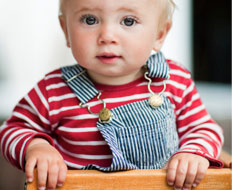The high chairs you keep on hand for your youngest customers are a welcome convenience for their moms and dads. But ensuring that high chair surfaces are cleaned and sanitized is often overlooked even in quick-service restaurants that employ the most disciplined hygiene procedures.
Careful high chair cleaning is one more way to ensure a great family dining experience. Not only does a clean, sanitized high chair contribute to a more pleasant, less stressful outing, it also helps prevent the spread of harmful bacteria and viruses capable of causing foodborne illness. Stopping the spread of foodborne pathogens is the best protection for your customers – and for the reputation and continued success of your restaurant.
Effective high chair hygiene takes more than a quick swipe with a cleaning cloth, says Gina McDowell, Food Safety Technical Consultant at Ecolab. It requires proper cleaning and sanitizing.
“Through the extensive tests we conduct in our laboratories at Ecolab, we continuously strive to deepen our understanding of how to reduce food-borne contamination on QSR surfaces,” McDowell says.
“While most non-food contact surfaces are not required to be cleaned as often as those used for food preparation, we know it’s important to clean and disinfect high chair trays as frequently as after each use. Anyone who has watched a toddler feed herself knows that it’s very likely that food will come in contact with the surface—and the millions of microorganisms that exist there.”
While high bacteria counts on a high chair tray may not correlate directly with the presence of disease-causing microorganisms, proper cleaning and sanitation, using procedures, products, and tools that have been proven effective, can reduce the total microorganism count and lower the risk spreading illness.
“Cleaning is an important first step because it removes soils and prepares the chair’s surfaces for effective sanitizing,” McDowell says. “Of course, cleaning a high chair with a dirty cleaning cloth defeats the purpose—and can even worsen the contamination by transferring harmful microorganisms harbored by the cloth to the high chair.”
Cleaning wipes away the visible food residues and dirt. But reducing the invisible contaminants—including the bacteria, viruses, and fungi that can cause disease—requires sanitizing or disinfecting. Sanitizers and disinfectants help defend against the microorganisms listed on their EPA-registered disinfectant labels. Importantly, they help restaurants reduce the risks of Norovirus, which, according to the Centers for Disease Control and Prevention (CDC), is the leading cause of foodborne disease outbreaks in the U.S. As such, disinfectants are a key tool in effective high chair hygiene and food safety.
Best Practice: Three Steps to Effectively Clean a High Chair
Ecolab’s McDowell offers the following three-step best practice for cleaning high chairs, a process she advises be carried out after each use.
Necessary supplies:
- Approved hard-surface sanitizer or disinfectant and sanitizer spray bottle
- Approved glass and multi-surface cleaner or detergent and spray bottle
- Clean foodservice towels
- Towel bucket
STEP 1. Clean the high chair by applying detergent or glass and multi-surface cleaner solution. Wipe with a clean food service towel until all visible soil is removed. Place towel in soiled towel bucket or discard.
STEP 2. Rinse the high chair by wiping its surfaces with another clean food service towel. Place towel in soiled towel bucket or discard.
STEP 3. Sanitize or disinfect the high chair tray by spraying with a hard-surface sanitizer or disinfectant solution. Allow to air dry.
By following these steps to clean and sanitize or disinfect your high chairs, you will help protect your youngest guests, ensure a pleasant experience that brings parents back, and keep the shine on your restaurant’s good reputation.
By Dixie Berg for Ecolab












